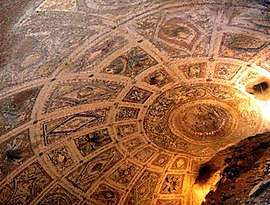Lupercal
| Lupercal | |
|---|---|
 First-century Roman sculpture in relief depicting the Roman foundation myth. Romulus and Remus are shown being suckled by a she-wolf in the Lupercal (Bottom left) | |
| Location | Palatine Hill in Rome |
| Depth | 15m |
| Discovery | January 2007 |

The Lupercal (from lupa, Latin for she-wolf) was a cave at the southwest foot of the Palatine Hill in Rome, located somewhere between the temple of Magna Mater and the Basilica di Sant'Anastasia al Palatino.[1] In the legend of Rome's foundation, Romulus and Remus were found there by a she-wolf who suckled them until they were rescued by the shepherd Faustulus. Luperci, the priests of Faunus, celebrated certain ceremonies of the Lupercalia at the cave, from the earliest days of the City until at least AD 494.
Modern discovery
In January 2007, Italian archaeologist Irene Iacopi announced that she had probably found the legendary cave beneath the remains of Emperor Augustus's house, the Domus Livia, on the Palatine. Archaeologists came across the 15-meter-deep cavity while working to restore the decaying palace.[2][3]
On 20 November 2007, the first set of photos were released showing the vault of the grotto which is encrusted with colourful mosaics, pumice stones and seashells. The center of the ceiling features a depiction of a white eagle, the symbol of the Roman Empire. Archaeologists are still searching for the entrance of the grotto.[4]

Its location below Augustus' residence is thought to be significant; Octavian, before he became Augustus, had considered taking the name Romulus to indicate that he intended to found Rome anew.[5][6]
Opposing opinions
Adriano La Regina (formerly Rome’s archaeological superintendent 1976-2004, professor of Etruscology at Rome’s La Sapienza University),[7] Professor Fausto Zevi (professor of Roman Archaeology at Rome's La Sapienza University)[8] and Professor Henner von Hesberg (head of the German Archaeological Institute, Rome)[9] denied the identification of the grotto with Lupercal on topographic and stylistic grounds. They concluded that the grotto is actually a nymphaeum or underground triclinium from Neronian times. The current scholarly consensus is that the grotto is not the Lupercal and that the cave was located lower southwest, closer to piazza Santa Anastasia.[10][11]
See also
References
- ↑ Vuković, Krešimir. "The Topography of the Lupercalia". The Papers of the British School at Rome. 86: 1–9. doi:10.1017/S0068246217000381.
- ↑ Valsecchi, Maria Cristina (26 January 2007). "Sacred Cave of Rome's Founders Discovered, Archaeologists Say". National Geographic News. National Geographic. Retrieved 20 November 2007.
- ↑ "Descubren la cueva donde Rómulo y Remo fueron amamantados por la loba" Archived 16 March 2009 at the Wayback Machine.
- ↑ Jaggard, Victoria (20 November 2007). "Photo in the News: Grotto of Rome's Founders Revealed". National Geographic News. National Geographic. Retrieved 21 November 2007.
- ↑ The New York Times, 22 October 2007.
- ↑ Suetonius, Vita Divi Augusti, I.7
- ↑ Aloisi, Silvia. "Expert doubts Lupercale 'find'", The Australian, 24 November 2007.
- ↑ "È uno splendido ninfeo, ma il Lupercale non era lì", la Repubblica, 23 November 2007.
- ↑ Schulz, Matthia. "Is Italy's Spectacular Find Authentic?" Spiegel Online, 29 November 2007.
- ↑ Coarelli, Filippo (2012). Palatium. Rome: Quasar. pp. 132–9.
- ↑ Vuković, Krešimir. "The Topography of the Lupercalia". The Papers of the British School at Rome. 86: 7–9.
|access-date=requires|url=(help)
